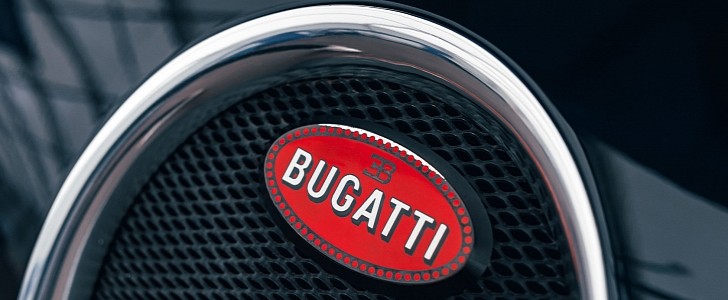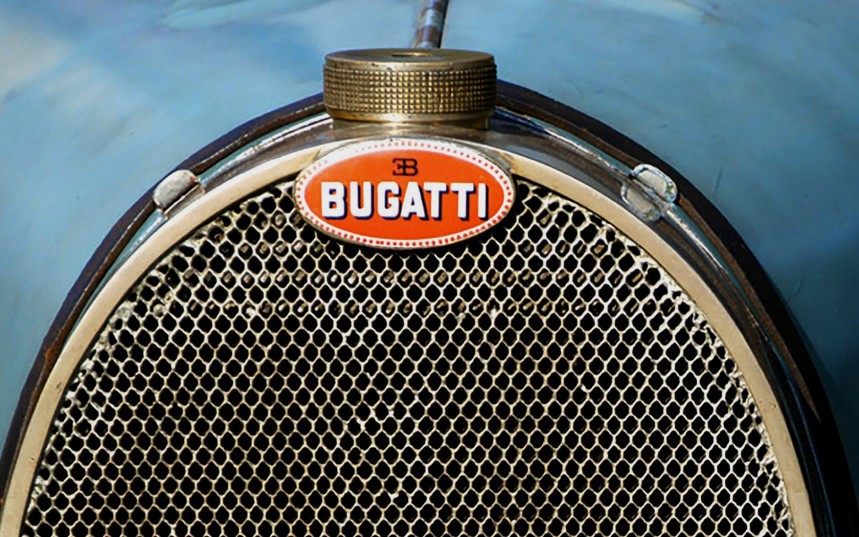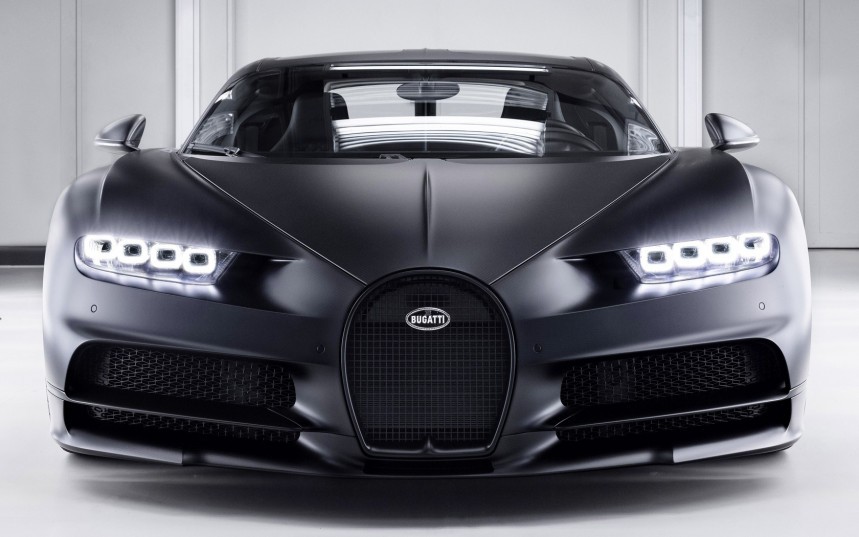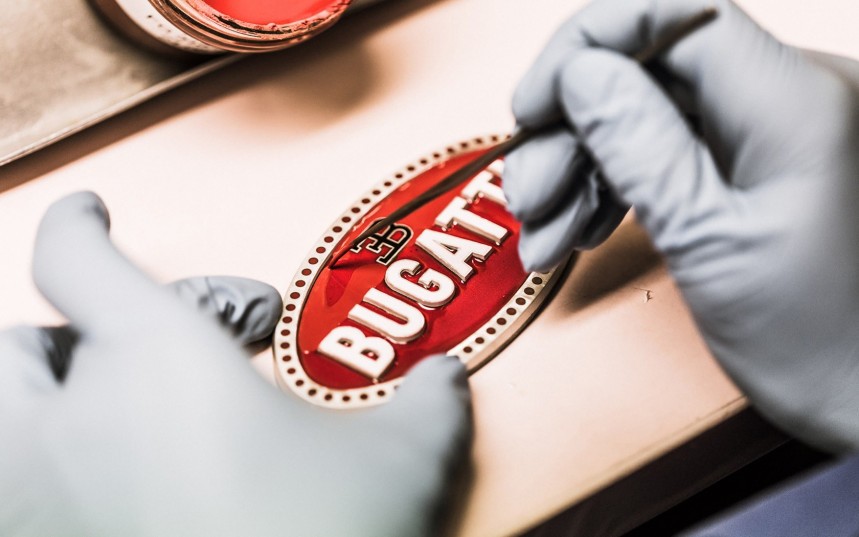Established by Milan-born industrial designer Ettore Bugatti in 1909, the carmaker was started in what was then the German city of Molsheim (currently in Alsace, France), and made a name for itself quickly, for the artistic nature of its car designs as well as the elevated level of craftsmanship and performance.
Bugatti, who was the son of an important Art Nouveau furniture and jewelry designer, was not only keen on building some of the fastest, most technologically advanced cars of their era but wanted them to also be elegant.
Toward the end of the year he founded the company, Bugatti realized that the only thing missing for his first car - the Type 13 - was an emblem that would symbolize the fine craftsmanship, durability, and distinctive elegance of the cars he wanted to build.
He had the idea of using an oval shape with white lettering on a red background, inspired by a similar logo he had developed for his earlier employer Deutz.
Above the easily readable letters, he chose to discreetly place his initials, EB, in black, as well as sixty red dots on a white border surrounding the oval emblem. According to the legend, they symbolize pearls in an Art Nouveau style.
Over the years, Ettore Bugatti made minor changes to these designs, as the so-called Macaron was featured on some of the most famous cars of the era, like the Type 35B, the car driven to victory by William Grover-Williams at the first-ever Monaco Grand Prix in 1929.
The modern-day emblems have been handcrafted for the last fifteen years by „Poellath GmbH & Co. KG Münz- und Prägewerk“, a family-owned company based in Bavaria that, among others has been manufacturing high-quality, embossed emblems for over two centuries.
The partnership with Bugatti initially started in 2003, when they manufactured the emblems for the Veyron 16.4.
In 2014 they took on a new project, developing the new emblems for the Chiron. The new emblem is larger, the border that includes the lettering and red dots is enameled and is placed on a separate level than the background, which now sits almost two millimeters lower than the border to create a tridimensional effect.
The distinct embossing is extremely precise even when examined very closely. Poellath also produces smaller badges like those on the car’s key.
Most of the emblems are delivered in red, with some cars like the Chiron Noire or SuperSport 300+ featuring a Macaron in black.
The badge weighs an impressive 159 grams, including the fastening screws, and might be the only part of a Bugatti that is not built with weight-saving in mind.
But like all Bugatti parts, there is an astonishing amount of labor and attention to detail invested in the creation of the Macaron. Around twenty skilled workers from different departments work on this elegant piece of automotive history for a total of ten hours.
The base of the emblem is made from 970 silver and is embossed several times, as part of a multi-stage process. In contrast to traditional casting methods, embossing creates much sharper contours and of much higher quality.
After this, the emblem passes through the enameling process, which is a technique that goes back hundreds of years, through which glass is fused to a metal base in a bond that is extremely difficult to dissolve. It also ensures the highest-quality colors that can be fused to the metal.
It is then partially polished by hand and the individual dots are also enameled. Finally, the fastening studs, which are made from a single piece, are brazed on and the emblem is checked once more.
This entire process is unique in the automotive industry and ensures that the Macaron will remain bright and colorful for decades if not centuries and will continue to symbolize the distinctive character and elegance of Bugatti.
Toward the end of the year he founded the company, Bugatti realized that the only thing missing for his first car - the Type 13 - was an emblem that would symbolize the fine craftsmanship, durability, and distinctive elegance of the cars he wanted to build.
He had the idea of using an oval shape with white lettering on a red background, inspired by a similar logo he had developed for his earlier employer Deutz.
Above the easily readable letters, he chose to discreetly place his initials, EB, in black, as well as sixty red dots on a white border surrounding the oval emblem. According to the legend, they symbolize pearls in an Art Nouveau style.
The modern-day emblems have been handcrafted for the last fifteen years by „Poellath GmbH & Co. KG Münz- und Prägewerk“, a family-owned company based in Bavaria that, among others has been manufacturing high-quality, embossed emblems for over two centuries.
The partnership with Bugatti initially started in 2003, when they manufactured the emblems for the Veyron 16.4.
In 2014 they took on a new project, developing the new emblems for the Chiron. The new emblem is larger, the border that includes the lettering and red dots is enameled and is placed on a separate level than the background, which now sits almost two millimeters lower than the border to create a tridimensional effect.
The distinct embossing is extremely precise even when examined very closely. Poellath also produces smaller badges like those on the car’s key.
Most of the emblems are delivered in red, with some cars like the Chiron Noire or SuperSport 300+ featuring a Macaron in black.
But like all Bugatti parts, there is an astonishing amount of labor and attention to detail invested in the creation of the Macaron. Around twenty skilled workers from different departments work on this elegant piece of automotive history for a total of ten hours.
The base of the emblem is made from 970 silver and is embossed several times, as part of a multi-stage process. In contrast to traditional casting methods, embossing creates much sharper contours and of much higher quality.
It is then partially polished by hand and the individual dots are also enameled. Finally, the fastening studs, which are made from a single piece, are brazed on and the emblem is checked once more.
This entire process is unique in the automotive industry and ensures that the Macaron will remain bright and colorful for decades if not centuries and will continue to symbolize the distinctive character and elegance of Bugatti.











